The Checker Maven
The World's Most Widely Read Checkers and Draughts Publication
Bob Newell, Editor-in-Chief
Published each Saturday morning in Honolulu, Hawai`i
Contests in Progress:
A Startling Reverse

The title for this problem was bestowed upon the position by Willie Ryan himself, as published posthumiously in the book Big League Checkers. Here's the position:
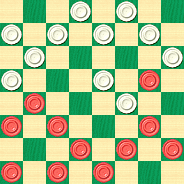
BLACK
Black to Play and Win
B:W31,30,28,27,26,25,24,21,20,18,14:B17,16,12,11,9,7,6,5,4,3,2.
Forces are even, but frankly, we don't really like the looks of the Black piece on 17. Can you come up with the move that turns the tables and wins the game?
Give it a spin, and if it all comes out backwards, turn around and click on Read More for the solution.![]()
Look Before You Leap

"Look Before You Leap" is good advice not just for the checker player but for life in general. Willie Ryan used that well-known phrase to title one of the positions in his famous Tricks, Traps, & Shots of the Checkerboard, more of which appears today as we continue our electronic republication of this unmatched classic.
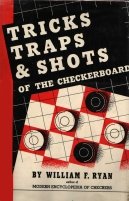
They'll Do It Every Time!
Here is a quick play on the ancient single corner opening that has been dropping the duffers since the days of Anderson and Wyllie. I've scored with this one on countless occasions in my exhibitions.
11-15 22-18 15-22 25-18 8-11 24-19 10-15 19-10 6-22 26-17 9-13 17-14 11-15 28-24 4-8---A.
A---Caught! Either 1-6 or 15-18 will draw.
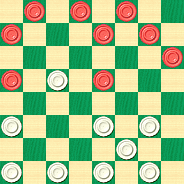
WHITE
White to Play and Win
W:W14,21,23,24,27,29,30,31,32:B1,2,3,5,7,8,12,13,15.
Look Before You Leap
One of the first lessons a beginner learns by sad experience is that moves that appear worthy are often the stepping stones to sudden defeat. The accompanying game illustrates the ever present danger of making plausible-looking moves without first considering the consequences of all possible replies. The following sequence of moves creates the pattern in the diagram:
11-15 23-19 8-11 22-17 4-8 17-13 15-18 24-20 9-14 28-24 10-15 19-10 6-15 26-23 12-16---A.
A---A natural advance that turns into a rout. The correct moves are: 15-19, 24-15, 5-9, 13-6, 1-26, 31-15, 11-18, 25-22, etc., resulting in a draw.
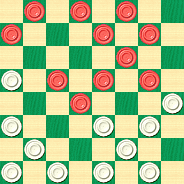
WHITE
White to Play and Win
W:W13,20,21,23,24,25,27,29,30,31,32:B1,2,3,5,7,8,11,14,15,16,18.
Editor's Note: We encourage you to take a good look at these positions before you leap to the solution by clicking on Read More.![]()
Oh My Goodness

We think we've chosen an appropriate title for this month's stroke problem, which at first glance looks as scary as that big snake in the photo above.
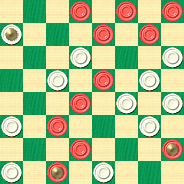
WHITE
White to Play and Win
W:WK5,10,12,14,16,19,20,21,24,29,31:B2,3,4,7,8,15,18,22,26,K28,K30.
Will you be squeezed by the complexity of the problem, or will you slither away successfully? Either way, click on Read More to uncoil the solution.![]()
What Is A Gem?

The definition of a 'gem' problem in checkers is not always clear. We like to think of this in a manner that extends the metaphor: a problem or situation that sparkles and is brilliant in its solution.
Today's installment of our Checker School series presents Dunne's Gem as published in Ben Boland's Famous Positions in the Game of Checkers. Here's the situation:
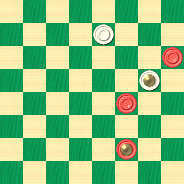
BLACK
Black to Play and Win
B:W26,K17:B21,14,K6.
Now, Black is a man up. What's so special, so gem-like, about this position (if, indeed, anything)?
Work out the solution and then you decide. Is this a true gem or just an ordinary lump of coal? As you might expect there is more here than meets the eye at first glance.
When you're ready, click on Read More for the solution, a sample game, and some notes, quotes, and votes.![]()
Instant Gratification

This month we're giving you not one or two but four speed problems. No, we're not being extra-generous; these problems are of a very easy nature and shouldn't take but an instant to solve.
And, knowing us, you know that therein lies the catch. We're giving you all of ten seconds to solve each problem. How good is your pattern recognition? Can you achieve instant gratification by immediately seeing the solutions, or will you be caught by our unforgiving time clock?
Click on Read More to check your solutions, but we doubt you'll need much help here.
Problem One (extremely easy)
Problem Two (extremely easy)
Problem Three (very easy)
Problem Four (very easy)![]()
Inexhaustible

In this age of computerized checkers, with the strongest programs now likely exceeding the capability of even the top human champions; and with the announced intention of the Chinook project to 'solve' the game completely, we often hear that checkers is exhausted, worn out, and no longer of interest.
Well, in this article we're about to disprove that notion--- as if it needed disproving.
Let's look at a position from Richard Pask's excellent book, Key Themes, which, by the way, we'll be offering here in a free, newly typeset electronic edition sometime in this spring (2006). The theme is "The Sunken Piece on Square 5" and we arrive at the diagram below from 11-15 23-19 9-14 22-17 5-9 17-13 14-18! 19-16 12-19 26-23 19-26 30-5.
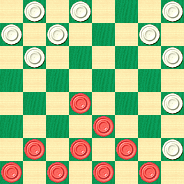
BLACK
Black to Play and Draw
B:W32,31,29,28,27,25,24,21,13,5:B15,10,8,7,6,4,3,2,1.
Let us first assure you that the position is indeed a draw. Black may be a man down but the White piece on square 5 is very much out of the action. Mr. Pask, in his book, gives a continuation from published play, resulting in a draw. But deep computer analysis shows that there are other possibilites, and the Black draw be obtained in at least a couple of different and very interesting ways.
We invite you to do your own analysis, and see how you think Black might draw. Then click on Read More for a few different takes on the position. We think you'll be completely convinced that, as far as the human mind is concerned, checkers is anything but old and tired, and is a truly limitless art.![]()
Brian's Bear Claw Still Unsolved

Brian Hinkle's challenging Bearclaw problem remains unsolved, and less than a month is left until we publish the solution. It's a tough nut to crack, but it's also a chance for the real two-fisted checker player to pull off a coup.
So don't pass up this last chance. Click here to see the problem again, and email your solution to Brian as quick as you can!![]()
Better Than First

Take careful note of our fisherman in the picture above. In a tranquil setting, he has a calm, relaxed mind, and he has focused his attention completely on the seemingly simple task of fishing.
But these supposedly easy things can, in their idyllic appearance, mask a great deal of depth and the often unexpected need for substantial skill and experience. Such is the case with today's feature problem, a miniature that will require focus, skill, and calmness of mind to solve.
And, you'll understand the title of our article, Better Than First, when you've found the solution.
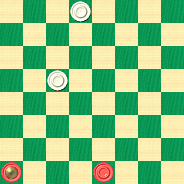
BLACK
Black to Play and Win
B:W31,19:BK4,2.
Were you able to solve it? Just click on Read More for the answer, and an explanation of the theme.![]()
Dead-End Duffers
Our electronic republication of Willie Ryan's incomparable Tricks Traps & Shots of the Checkerboard continues this week with two situations which Willie says he has used often to bring down less skilled opponents. Here's what Willie has to say about all this.

Drummond's Dead End
Among the relatively few pitfalls I have used hundreds of times in my exhibition demonstrations, this old acorn by bumptious John Drummond, a fiery Scotsman with a pronounced talent at draughts, ranks high. Rack up the pieces. Then move: 9-14, 22-18, 5-9, 25-22, 11-16, 29-25, 16-20, 24-19, 8-11, 28-24---A, forming the position shown on the diagram.
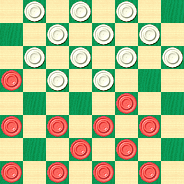
BLACK
Black to Play and Win
B:W32,31,30,27,26,25,24,23,22,21,19,18:B20,14,12,11,10,9,7,6,4,3,2,1.
A---No hope for white after this. The only move to draw is: 21-17, 14-21, 18-15, 11-18, 23-5, 4-8, 22-18, 20-24, 27-20, 8-11, 18-14, 10-17, 26-23, 6-10, 31-26, 10-14, 25-22, 11-16, 22-13, 21-25, 30-21, 14-18, 20-11, 7-16, 23-14, 16-30, etc. Wm. F. Ryan.
Decoy For Duffers
This eight-move plot has led countless novices of the game to a defeat begotten by careless procedure. Let's set up the pieces for play. Now move 10-15, 22-18, 15-22, 25-18, 6-10, 29-25, 10-15; at this point 25-22---A loses, bringing us up to the layout on the diagram.
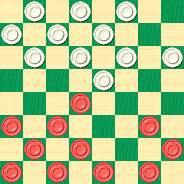
BLACK
Black to Play and Win
B:W32,31,30,28,27,26,24,23,22,21,18:B15,12,11,9,8,7,5,4,3,2,1.
At A, white can play either 26-22 or 18-14 with a firm position in hand.
Editor's Note: Dead-end duffers and charging champions alike can click on Read More to see Willie's solutions to these problems.![]()
Easy or Hard? It All Depends...

Is this month's stroke problem an easy one, a hard one, or something in-between?
We guess it all depends: on your mood or degree of alertness on any given day; on your overall checker skill; on your ability to visualize complex situations; or on a whole host of other possible factors, including, sometimes, just taking a lucky guess.
So we won't presume to judge. We'll let you make the call.
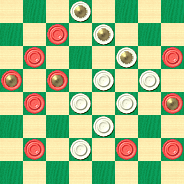
WHITE
White to Play and Win
W:WK2,K7,K11,15,16,18,19,23,26:B6,9,12,K13,K14,17,K20,25,27,28.
How did you do? Easy or hard? Well, one thing we know is easy: that's clicking on Read More to check your solution.![]()
The Checker Maven is produced at editorial offices in Honolulu, Hawai`i, as a completely non-commercial public service from which no profit is obtained or sought. Original material is Copyright © 2004-2025 Avi Gobbler Publishing. Other material is the property of the respective owners. Information presented on this site is offered as-is, at no cost, and bears no express or implied warranty as to accuracy or usability. You agree that you use such information entirely at your own risk. No liabilities of any kind under any legal theory whatsoever are accepted. The Checker Maven is dedicated to the memory of Mr. Bob Newell, Sr.

